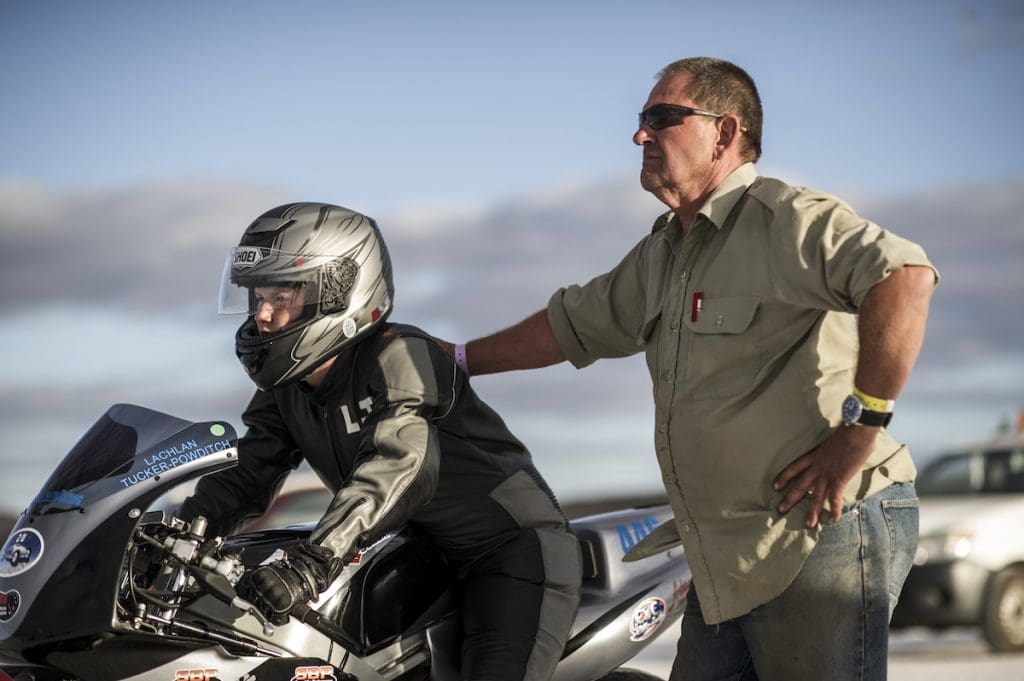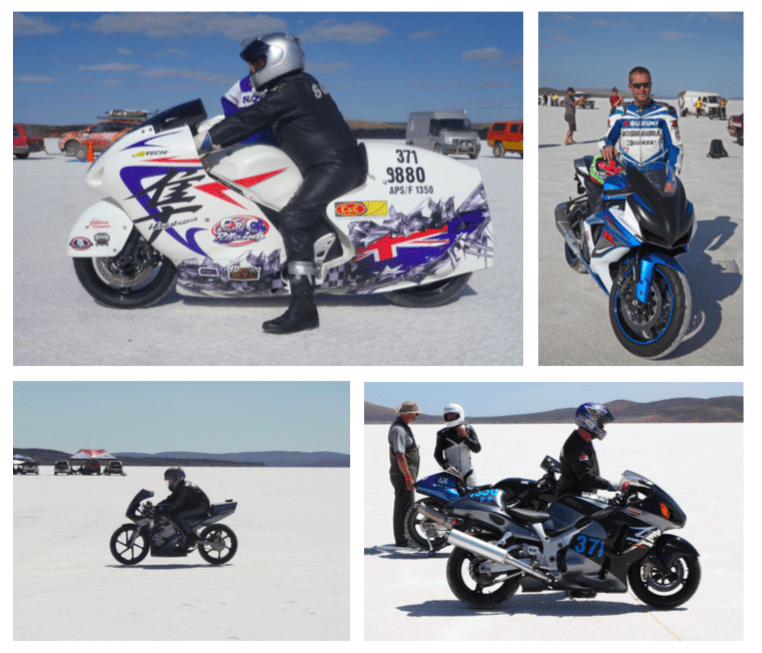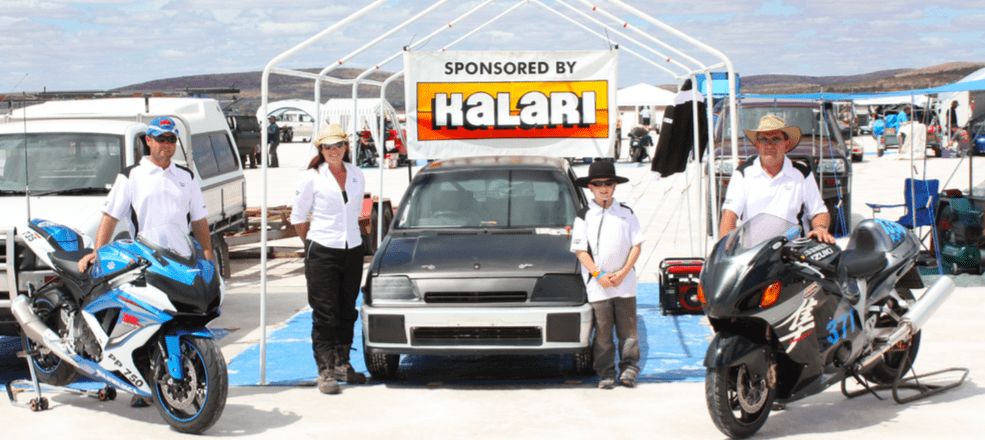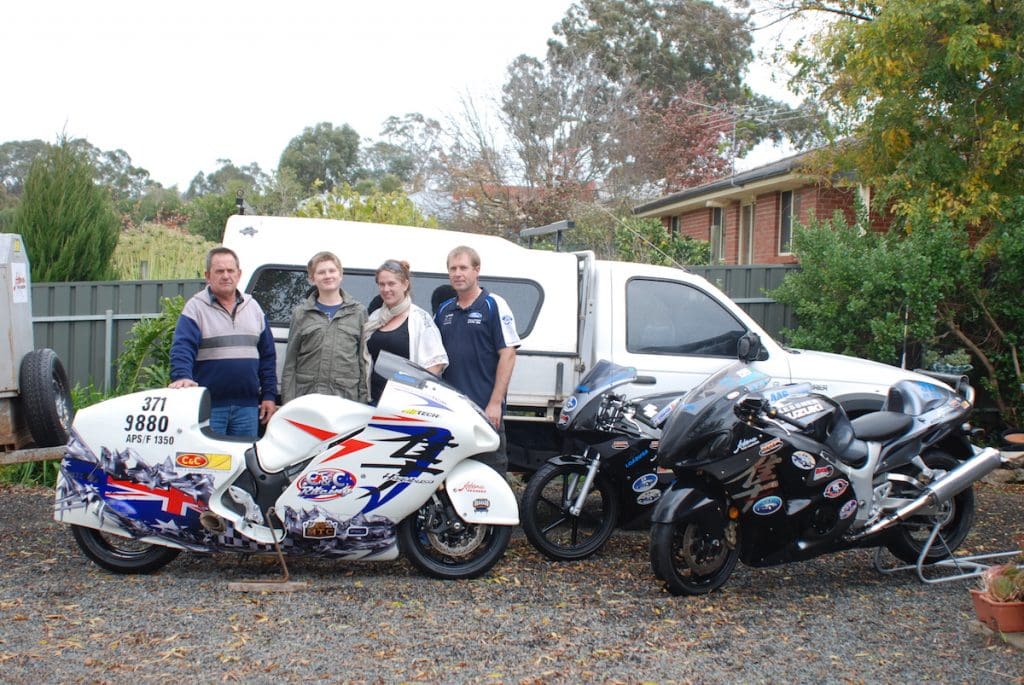The sheet of salt stretches to the horizon. A youngster sits quietly at the start line on the motorcycle his grandfather has built. That man is waiting too, his hand resting on the kid’s shoulder. This is a special moment on Lake Gairdner. Out here it’s all blinding white and vivid blue. Salt and sky. Out here a rider is alone with his thoughts on the start line. Then, after he receives the starting board with the green thumbs-up “Go” sign, is alone with his fears and a helmet full of the noise of an engine at full revs. The mile markers flash past as the machine reaches terminal velocity.
Then it’s a long wind-down back through the engine revs and on to the return road. One good run. One new record.
Lachlan Tucker-Powditch is just 13 years old. He’s been coming to the salt since he was two years old. Earlier this year he achieved a personal ambition by competing for the first time. This resulted in two world firsts: he became the world’s youngest ever competitor in this sport and set an Australian land speed record in his class.
The Year Eight pupil took his homebuilt 1998 Moriwaki chassis, powered by a Suzuki RM85 motocross engine, to 91.7mph in the 100 APS-G class. The old record was 89.7mph. (Like drag racing, salt-lake times are measured in miles per hour rather than metric).

Meanwhile his father, Paul Powditch, took his 2011 GSX-R1000 Suzuki to a record-breaking 192.364mph in the 1000 MPS-G (production) class. The old record was 188.442mph.
What about grandpa, the cause of all this high-speed ambition?
Grant Schlein powered his 2003 Suzuki Hayabusa to 209.839mph in the 1350 P-P (production) class, beating Kawasaki Australia’s 208.153mph set in 2013.
He then jumped on a 2008 semi-streamlined Hayabusa and hit 221.206mph before backing off as the front wheel started lifting. The old record in this 1350 APS-F class was 210.995.
Lachlan’s mum, Rebekah Tucker-Powditch, was watching and listening.
“They disappear in a big rooster tail but I know them by the sound,” she said later. “Even if I can’t see them, I can tell who’s on what bike by the exhaust.
“There is nothing like the sound of an engine at full revs for mile after mile.”
Rebekah should know. She has driven her 1988 Suzuki Swift GTI at more than 200km/h across this vast expanse of salt.
Riding Suzuki motorcycles and setting land-speed records runs deep in this family.
It is a contagious disease that even affects cousin Martin Powditch, who this year smashed the 650 APS-G class record of 75.917mph with a blistering 130.592mph on a 2008 Hyosung 650cc.

BACK IN THE SUBURBS
The clan gathers at granddad’s house for a debrief in a garage full of Suzukis.
“It’s always been Suzuki for me,” says Grant, pointing to a Kessner sticker on his old early-’90s drag bike. This Adelaide Suzuki and KTM dealer has supported the 59-year-old since 1977. It’s helped assist his road racing, drag-racing – and now salt racing.
When the time came to build a bike for grandson Lachlan the choice of engine was not an issue. Out came the tired old Honda powerplant from the Moriwaki and in went a two-stroke Suzi.
So what was the experience like for Lachlan?
“I didn’t find it scary,” he says. “I thought I was going slower than I was,” he continues, describing in a few words how the vast expanse of salt destroys the perception of speed. The fastest he’d gone before this was 80km/h on dirt-bike rides in the bush near Port Pirie with his parents.
What revs did he hold the engine at?
“Around 13,800rpm,” he replies.
A motocross engine isn’t intended to sit on full revs for very long so 14,000rpm across three miles is a test of preparation.
Granddad adds some perspective to this.

“It’s a test of an engine for sure,” Grant says. “Paul’s GSX-R1000 would be sitting on 15,000rpm and my ’Busan on 10,600rpm.
“Look, mate, all the winning in salt-lake racing is done in the shed.
“You can’t start doing major work on your bike on the salt. The preparation has to be complete before you go.”
So what is the level of preparation to achieve record results?
“I go through everything in detail,” Grant replies. “I even do the wheel alignment using a vernier to get it millimetre perfect.”
So there must be some basic cornerstones?
“They are traction – which includes gearing, weight distribution and tyre pressures – aerodynamics, and riding style, by which I mean really learning to get your body down into the bike,” says Grant.
He gives an example of jumping on a friend’s ’Busa and going three miles an hour faster just by tucking into the paintwork more than the owner.
Paul then tells the story of a turbocharged ’Busa that could only hit 160mph. It’s an example of the complexity of this type of racing, where throwing horsepower at a motorcycle doesn’t necessarily make it go faster.
A classic case is the fact that the Gen One ’Busa, produced from 1999 to 2008, is still favoured by many salt racers over its successor.

FAMILY TIES
Grant’s link to Suzuki dates back to the 1970s, when he started roadracing.
Like many racers juggling family and work commitments, a succession of Suzukis passed through his hands.
“At one stage I had to buy some curtains for the house, so I sold my ex-Mick Hone T500,” he remembers.
Fast-forward a decade and Grant was one of the large group of Adelaide racers showing Australia how good the Suzuki GSX-R1100 engine was. Try a quarter mile time of 8.7 seconds with a terminal speed of 152mph!
A partnership with engine tuner Jim “Platypus” Hanlon continued into the 2000s, when Grant discovered salt-lake racing. Another long-term supporter and friend is Mick Adi, of Advance Headers. (He’s a bit mad too, racing a Goggomobil Dart powered by a supercharged, methanol-burning VW engine).
In 2004 Grant became the first Aussie motorcyclist inducted into the 200mph Club with a run of 200.9mph (323km/h) at Lake Gairdner.
Amazingly, it was his first year on the salt and he even upped the ante during the week, hitting 204.1mph.
By 2010 Grant had his daughter Rebekah and son-in-law Paul Powditch out competing with him.
Paul took his 2008 GSXR-750 to a production 750cc record of 162.954mph and reset the modified MPS/G 750 record to 167.566mph. Rebekah then drove her Hanlon-prepped Suzuki GTI Swift to 125.226mph.
To prove he wasn’t just fast on the salt, Grant took his ’Busa to Tasmania’s Longford Revival Festival in early 2011.
His speed of 291.42km/h over the Flying Mile was just 1.58km/h off the record set by Formula One driver Chris Amon’s Ferrari V12 in 1968.
To put Grant’s effort into perspective on that bumpy, wind-buffeted track, the fastest car in 2011 was a Holden Monaro at a mere 252km/h.
Back on the salt, Kawasaki Australia’s record-breaking effort in 2013 got Suzuki fanatic Grant fired up.
The Ninja ZX-14R hit 208.153 to set a new Australian Production Frame-Production Engine (P-P) 1650cc record.
It was the fastest speed any standard bike had achieved in Australia.
Grant responded in typical fashion, dragging out the standard-spec Gen One ’Busa he hadn’t ridden on the salt since 2010.
Despite displacing 1299cc, compared to the Kawa’s 1441cc, Grant took the record back with a stunning 209.839mph.
It was proof that salt-lake racing reduces motorcycle competition to its simplest form.
To go far and fast all you need is self-belief and basic workshop ingenuity.
Speaking of which, what plans has Grant for grandson Lachlan?
“We are getting a Cagiva Mito for next year,” he says.
Plenty of people have fitted Yamaha’s RD350 engine to a Mito chassis. Expect Grant to slot a Suzuki in.
“This is his life, it really is,” says daughter Rebekah.

by HAMISH COOPER
PHOTOGRAPHY HAMISH COOPER, TUCKER-POWDITCH archives











